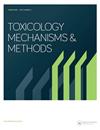Toxicity and oxidative stress induced by T-2 toxin in cultured mouse Leydig cells
IF 2.7
4区 医学
Q2 TOXICOLOGY
引用次数: 24
Abstract
Abstract To explore the toxic mechanism of T-2 toxin on Leydig cells of mice, we would investigate the toxicity and oxidative stress induced by T-2 toxin in the cells. Leydig cells were isolated and cultured with control or T-2 toxin (10−7 M, 10−8 M, or 10−9 M) for 24 h, then cells and supernatants were harvested to examine cell viability, superoxide dismutase (SOD), glutathione peroxidase (GSH-Px) and catalase (CAT) activities, expression of messenger RNA (mRNA) related to oxidative stress, malondialdehyde (MDA) content and DNA damage. The cell viability was evaluated in mouse Leydig cells by MTT assay, MDA content and SOD, GSH-Px and CAT activities were measured by routine kits, expression of mRNA related to oxidative stress were examined by quantitative real-time polymerase chain reaction (PCR), and DNA damage was investigated by comet assay. Leydig cells treated with T-2 toxin showed significant reductions in cell viability, SOD, GSH-Px and CAT activities, and expression of mRNA related to oxidative stress, and remarkable increases in MDA content and levels of DNA damage. This study proves that T-2 toxin is toxic to Leydig cells of mice. Furthermore, oxidative stress plays an important role in the above-mentioned negative effects of T-2 toxin.T-2毒素对小鼠间质细胞的毒性及氧化应激作用
摘要为了探讨T-2毒素对小鼠间质细胞的毒性作用机制,我们将研究T-2毒素对小鼠间质细胞的毒性作用及引起的氧化应激。分离间质细胞,用对照或T-2毒素(10−7 M、10−8 M或10−9 M)培养24 h,然后收集细胞和上清液,检测细胞活力、超氧化物歧化酶(SOD)、谷胱甘肽过氧化物酶(GSH-Px)和过氧化氢酶(CAT)活性、氧化应激相关信使RNA (mRNA)表达、丙二醛(MDA)含量和DNA损伤。采用MTT法检测小鼠间质细胞活力,常规试剂盒检测MDA含量、SOD、GSH-Px和CAT活性,实时荧光定量PCR检测氧化应激相关mRNA表达,comet法检测DNA损伤。T-2毒素处理后,间质细胞的细胞活力、SOD、GSH-Px和CAT活性以及氧化应激相关mRNA的表达均显著降低,MDA含量和DNA损伤水平显著升高。本研究证实T-2毒素对小鼠间质细胞具有毒性。此外,氧化应激在T-2毒素的上述负作用中起重要作用。
本文章由计算机程序翻译,如有差异,请以英文原文为准。
求助全文
约1分钟内获得全文
求助全文
来源期刊

Toxicology Mechanisms and Methods
TOXICOLOGY-
自引率
3.10%
发文量
66
期刊介绍:
Toxicology Mechanisms and Methods is a peer-reviewed journal whose aim is twofold. Firstly, the journal contains original research on subjects dealing with the mechanisms by which foreign chemicals cause toxic tissue injury. Chemical substances of interest include industrial compounds, environmental pollutants, hazardous wastes, drugs, pesticides, and chemical warfare agents. The scope of the journal spans from molecular and cellular mechanisms of action to the consideration of mechanistic evidence in establishing regulatory policy.
Secondly, the journal addresses aspects of the development, validation, and application of new and existing laboratory methods, techniques, and equipment. A variety of research methods are discussed, including:
In vivo studies with standard and alternative species
In vitro studies and alternative methodologies
Molecular, biochemical, and cellular techniques
Pharmacokinetics and pharmacodynamics
Mathematical modeling and computer programs
Forensic analyses
Risk assessment
Data collection and analysis.
 求助内容:
求助内容: 应助结果提醒方式:
应助结果提醒方式:


